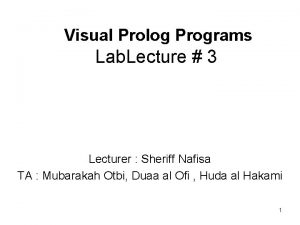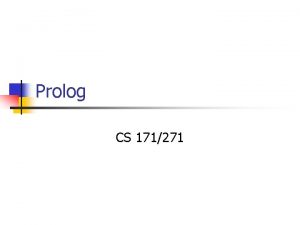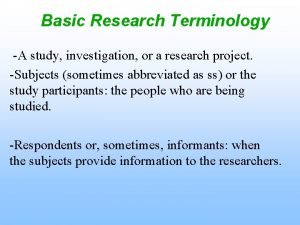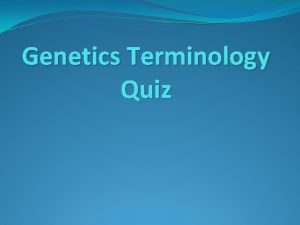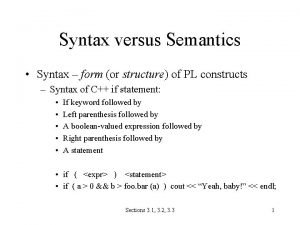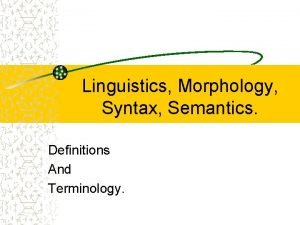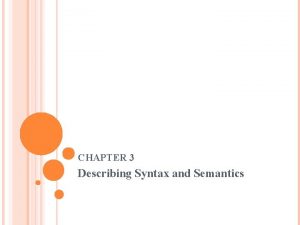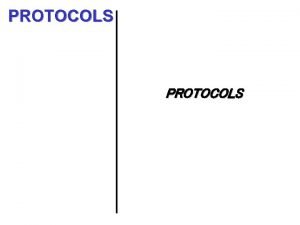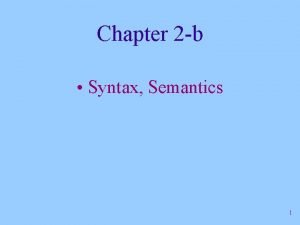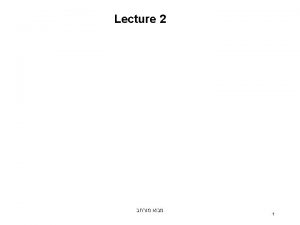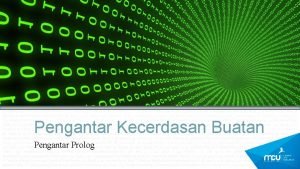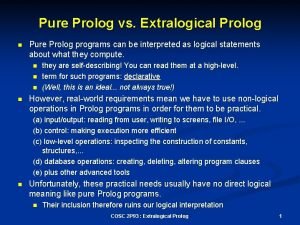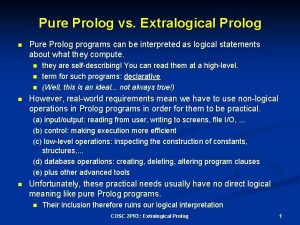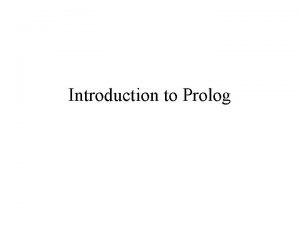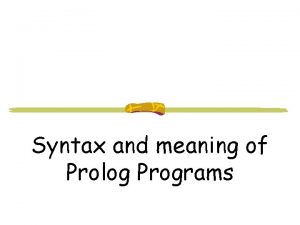Syntax and Semantics of Prolog v Syntax Terminologies






![Can You Spot Any Syntax Errors? Student_id(adam, 04971111) done : - do[1], do[2] do[3]. Can You Spot Any Syntax Errors? Student_id(adam, 04971111) done : - do[1], do[2] do[3].](https://slidetodoc.com/presentation_image_h/ca4b002921d08f48722eba9e0fc6bdf4/image-7.jpg)





- Slides: 12

Syntax and Semantics of Prolog v Syntax + Terminologies v Data Types v Search Tree (Proof Tree) v Unification v Backtracking

Prolog Program consists of • Facts - unconditional statement boy_names(john, 1700, 1). likes(rong, prolog). • Rules - conditional statement likes(rong, X): - likes(X, prolog). grandparent(X, Y): - parent(X, Z), parent(Z, Y). • Queries - something need to be proved (or goal needs to be solved)

Some Funny Terminologies • • Head Body Neck Tail gp(X, Y) : - p(X, Z), p(Z, Y). • Clause • Goal

Data Objects in Prolog • Variable - represents unknown object • Constant - represents simple instance Ø atom Ø number • Nested Structure Ø list – represents a sequence of objects Ø structure - represents compound objects (all data objects are called terms)

Syntax - Data Objects • Variable - strings starting with a capital letter strings starting with a ‘_’ • Constant Ø atom - strings starting with a lower-case letter, and any strings enclosed in single quotes Ø number – same as numbers in Java • Nested Structure Ø list - [term, … term] Ø structure - atom(term, …)

Syntax – Prolog Program A Prolog program consists of either goal. or goal : - goal, …, goal. A goal can be either atom (i. e. a name without arguments) or atom(term, …) A term can be either variable, constant, or nested structure
![Can You Spot Any Syntax Errors Studentidadam 04971111 done do1 do2 do3 Can You Spot Any Syntax Errors? Student_id(adam, 04971111) done : - do[1], do[2] do[3].](https://slidetodoc.com/presentation_image_h/ca4b002921d08f48722eba9e0fc6bdf4/image-7.jpg)
Can You Spot Any Syntax Errors? Student_id(adam, 04971111) done : - do[1], do[2] do[3]. done(Job : - design(Job), imp(Job), test(Job), likes(tom marry).

How Does a Prolog Program Work - by example program: father(john, ben). father(john, steve). father(steve, chris). father(chris, adam). father(steve, tom). …… grandfather(X, Z) : father(X, Y), father(Y, Z). ? - father(steve, X).

How Does a Prolog Program Work - by example program: father(john, ben). father(john, steve). father(steve, chris). father(chris, adam). father(steve, tom). …… grandfather(X, Z) : father(X, Y), father(Y, Z). ? - grandfather(X, chris). ? - f(X, Y), f(Y, chris).

Unification There is a matching operation between the goal and the head of clause. This matching operation is called unification. Rules of unification: • a variable can unify with any term; • two constants (i. e. number or atom) can be unified if they are same; • two structures can be unified if they have same name and all arguments can be unified.

An Example: Simplify an Arithmetic Expression Problem: given an expression like 3+x+0, we want to change it to 3+x, i. e. remove redundant 0 s. What are the rewriting rules? 1. simplify E+0 to E 2. simplify 0+E to E 3. keep E 1+E 2 unchanged if both E 1 and E 2 are not 0.

A Prolog Program to Simplify Arithmetic Expressions rules_for_plus(X, 0, X). rules_for_plus(0, X, X). rules_for_plus(X, Y, X+Y): - X == 0, Y == 0. simp(X, X): - atomic(X). simp(X+Y, New. XY): simp(X, New. X), simp(Y, New. Y), rules_for_plus(New. X, New. Y, New. XY).
 Visual studio prolog
Visual studio prolog Download prolog
Download prolog Compare procedural semantics and declarative semantics.
Compare procedural semantics and declarative semantics. Itsm terms and terminologies
Itsm terms and terminologies Security terminologies and principle
Security terminologies and principle Ethical hacking terminologies
Ethical hacking terminologies Basic research terminology
Basic research terminology Define dominant trait
Define dominant trait Citation more than 3 authors
Citation more than 3 authors Syntax vs semantics
Syntax vs semantics Syntax morphology semantics
Syntax morphology semantics Describing syntax
Describing syntax Syntax semantics and timing
Syntax semantics and timing
